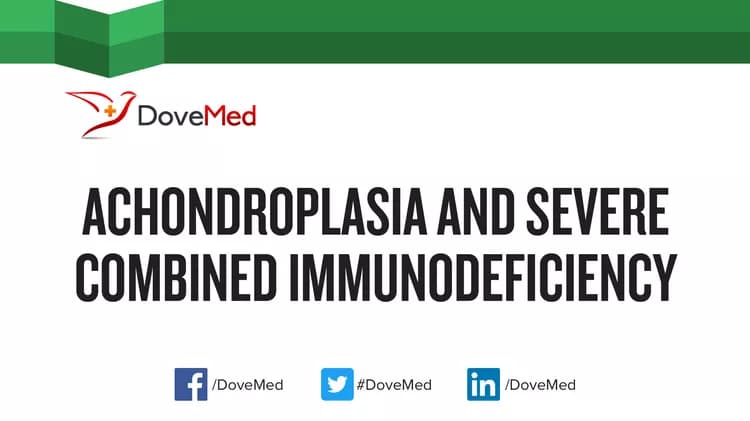What are the other Names for this Condition? (Also known as/Synonyms)
- Achondroplasia and Severe Combined Immunodeficiency
- Short-Limb Skeletal Dysplasia with Severe Combined Immunodeficiency
- SLSD with SCID
What is Achondroplasia with Severe Combined Immunodeficiency? (Definition/Background Information)
- Achondroplasia with (and) Severe Combined Immunodeficiency (SCID) is an extremely rare type of SCID. The condition is inherited in an autosomal recessive manner
- Achondroplasia with Severe Combined Immunodeficiency is characterized by the classic signs of SCID, including severe and recurrent infections, diarrhea, failure to thrive, and absence of T lymphocytes and B lymphocytes, along with skeletal anomalies like short stature, bowing of the long bones and other abnormalities affecting the ends of the long bones (metaphyseal abnormalities)
- Children with this condition have a shortened life expectancy, generally surviving only into early childhood
(Source: Achondroplasia and Severe Combined Immunodeficiency; Genetic and Rare Diseases Information Center (GARD) of National Center for Advancing Translational Sciences (NCATS), USA.)
Who gets Achondroplasia with Severe Combined Immunodeficiency? (Age and Sex Distribution)
- Achondroplasia with Severe Combined Immunodeficiency is a rare congenital disorder. The presentation of symptoms may occur at birth
- Both males and females may be affected
- Worldwide, individuals of all racial and ethnic groups may be affected
What are the Risk Factors for Achondroplasia with Severe Combined Immunodeficiency? (Predisposing Factors)
- A positive family history may be an important risk factor, since Achondroplasia with Severe Combined Immunodeficiency can be inherited
- Currently, no other risk factors have been clearly identified for this condition
It is important to note that having a risk factor does not mean that one will get the condition. A risk factor increases one’s chances of getting a condition compared to an individual without the risk factors. Some risk factors are more important than others.
Also, not having a risk factor does not mean that an individual will not get the condition. It is always important to discuss the effect of risk factors with your healthcare provider.
What are the Causes of Achondroplasia with Severe Combined Immunodeficiency? (Etiology)
- The gene mutation that causes Achondroplasia with Severe Combined Immunodeficiency is not known
Autosomal recessive: Autosomal recessive conditions are traits or disorders that occur when two copies of an abnormal gene have been inherited on a non-sex chromosome. If both parents have an autosomal recessive condition, there is a 100% likelihood of passing on the mutated genes to their children. If, however, only one mutant copy of the gene is inherited, the individual will be a carrier of the condition, but will not be present with any symptoms. Children born to two carriers, have a 25% chance of being homozygous dominant (unaffected), a 50% chance of being heterozygous (carrier), and a 25% chance of being homozygous recessive (affected).
What are the Signs and Symptoms of Achondroplasia with Severe Combined Immunodeficiency?
The signs and symptoms of Achondroplasia with Severe Combined Immunodeficiency may include:
Very frequently present symptoms in 80-99% of the cases:
- Abnormality of the metaphysis
- Cellular immunodeficiency
- Lymphopenia
- Recurrent respiratory infections
- Severe combined immunodeficiency
Frequently present symptoms in 30-79% of the cases:
- Agammaglobulinemia
- Biparietal narrowing
- Fine hair
- Reduced bone mineral density
Occasionally present symptoms in 5-29% of the cases:
- Abnormality of the pancreas
- Aganglionic megacolon
- Anemia
- Cognitive impairment
- Inguinal hernia
- Long fibula
- Malabsorption
- Pectus excavatum
- White hair
The following additional signs and symptoms may be present in some individuals:
- Abnormality of the thorax
- Hypoplasia of the thymus
- Metaphyseal chondrodysplasia
(Source: Achondroplasia and Severe Combined Immunodeficiency; Genetic and Rare Diseases Information Center (GARD) of National Center for Advancing Translational Sciences (NCATS), USA.)
How is Achondroplasia with Severe Combined Immunodeficiency Diagnosed?
Achondroplasia with Severe Combined Immunodeficiency is diagnosed on the basis of the following information:
- Complete physical examination
- Thorough medical history evaluation
- Assessment of signs and symptoms
- Laboratory tests
- Imaging studies
- Biopsy studies, if necessary
Many clinical conditions may have similar signs and symptoms. Your healthcare provider may perform additional tests to rule out other clinical conditions to arrive at a definitive diagnosis.
What are the possible Complications of Achondroplasia with Severe Combined Immunodeficiency?
The complications of Achondroplasia with Severe Combined Immunodeficiency may include:
- Labored breathing due to skeletal abnormalities
- Recurrent, severe infections
- Pneumonia
Complications may occur with or without treatment, and in some cases, due to treatment also.
How is Achondroplasia with Severe Combined Immunodeficiency Treated?
There is no cure for Achondroplasia with Severe Combined Immunodeficiency, since it is a genetic condition. The treatment is usually given to manage the signs and symptoms and any complication that develops
How can Achondroplasia with Severe Combined Immunodeficiency be Prevented?
- Achondroplasia with Severe Combined Immunodeficiency may not be preventable, since it is a genetic disorder
- If a family has a history of an affected child, then genetic counseling will help assess risks, before planning for another child
- Active research is currently being performed to explore the possibilities for treatment and prevention of inherited and acquired genetic disorders
- Regular medical screening at periodic intervals with tests and physical examinations are recommended
What is the Prognosis of Achondroplasia with Severe Combined Immunodeficiency? (Outcomes/Resolutions)
- The prognosis of Achondroplasia with Severe Combined Immunodeficiency is generally poor
- Typically, children born with the condition are known to die during childhood
Additional and Relevant Useful Information for Achondroplasia with Severe Combined Immunodeficiency:
The following DoveMed website link is a useful resource for additional information:
Related Articles
Test Your Knowledge
Asked by users
Related Centers
Related Specialties
Related Physicians
Related Procedures
Related Resources
Join DoveHubs
and connect with fellow professionals


0 Comments
Please log in to post a comment.